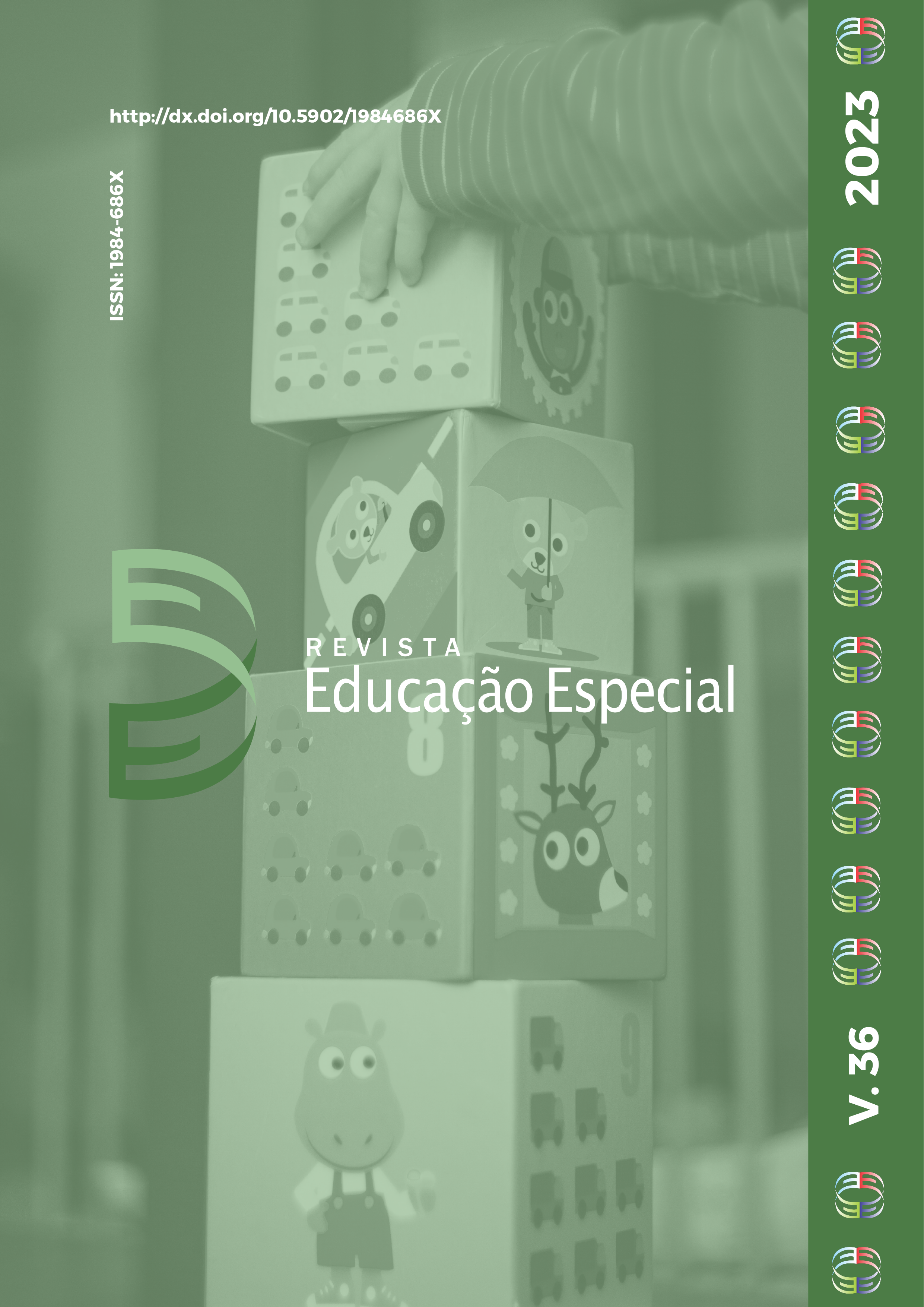Deaf education and art teaching in the context of the bilingual school
DOI:
https://doi.org/10.5902/1984686X72147Keywords:
Deaf, Teaching, Deaf ArtAbstract
The teaching of art in the early years of Elementary School presents the four languages (Visual Arts, Dance, Music, and Theater) in an integrated way and from a playful perspective. The study aims to analyze the teaching of art in the education of deaf children from the bilingual school perspective. The research is qualitative and interpretive. A teacher and seven students from a deaf bilingual school in Paraná participated in the study. The data were analyzed using a qualitative approach. The data collection instruments were observation, interviews and application of activities, content analysis perspective of content analysis. Concluded that teaching art to deaf students must occur from the beginning of their schooling. Through this art, they find a way to affect their communication, demonstrate feelings, and construct meanings. It highlights the importance of teaching art in a bilingual school’s classrooms and how much this subject can contribute to the educational development of deaf students.
Downloads
References
BRASIL. Ministério da Educação. Parâmetros Curriculares Nacionais: arte. Brasília: MEC/SEF, 1997.
BRASIL. Lei nº 10.436 de abril de 2002. Dispõe sobre a Língua Brasileira de Sinais - Libras e dá outras providências. Disponível em: https://www.libras.com.br/lei-10436-de-2002. Acesso em: 14 dez. 2021.
BRASIL. Decreto nº 5.626de 22 de dezembro de 2005. Dispõe sobre a Língua Brasileira de Sinais – Libras. Disponível em: https://www2.camara.leg.br/legin/fed/
decret/2005/decreto-5626-22-dezembro-2005-539842-publicacaooriginal-39399-pe.html. Acesso em: 14 dez. 2021.
BRASIL. Ministério da Educação. Base Nacional Comum Curricular: Educação Infantil e Ensino Fundamental. Brasília: MEC/Secretaria de Educação Básica, 2018.
CAMPOS, M. de L. I. L. Educação Inclusiva para surdos e as políticas vigentes. In: LACERDA, C. F. de.; SANTOS, L. F. dos. (org.). Tenho um aluno surdo, e agora? Introdução à Libras e educação de surdos. São Carlos: EdUFSCar, 2013. p. 37-62.
CRUZ, A. N. R. da. Aula de arte para com surdos : criando uma prática de ensino. Dissertação (Mestrado em Artes) - Universidade Estadual Paulista Júlio de Mesquita Filho, Instituto de Artes.São Paulo, 2016.
GESSER, A. LIBRAS? Que língua é essa? crenças e preconceitos em torno da língua de sinais e da realidade surda. São Paulo: Parábola Editorial, 2009.
GIL, A. C. Como elaborar projetos de pesquisa. 6 ed. São Paulo: Atlas, 2017.
GOLDFELD, M. A criança surda – linguagem e cognição numa perspectiva sociointeracionista. 2ª ed. São Paulo: Plexus, 1997.
IBGE. Instituto Brasileiro de Geografia e Estatística. Censo Demográfico 2010: Características gerais da população, religião e pessoas com deficiência. Rio de Janeiro: IBGE, 2010. Disponível em: https://biblioteca.ibge.gov.br/visualizacao/periodicos/94/cd_2010_religiao_deficiencia.pdf. Acesso em: 20 nov. 2020.
INES. Instituto Nacional de Educação de Surdos. Telas da artista surda Nancy Rourke: força e intensidade das cores em movimentos de resistência, afirmação e libertação. Revista Espaço, Rio de Janeiro, n.52, jul-dez, 2019.
KARNOPP, L. B.; KLEIN, M.; LUNARDI-LAZZARIN, M. L. Produção, circulação e consumo da cultura surda brasileira. In: KARNOPP, L. B.; KLEIN, M.; LUNARDI-LAZZARIN, M. L. (Org.) Cultura Surda na contemporaneidade: negociações, intercorrências e provocações. Canoas: Ed. ULBRA, 2011, P. 15-28.
LÜDKE, M.; ANDRÉ, M. E. D.A. Pesquisa em educação: uma abordagem qualitativa. 2 ed. [Reimp.] Rio de Janeiro: E. P. U, 2018.
OLIVEIRA, A. L. N. As tecnologias e a educação de alunos surdos. Trabalho de Conclusão de Curso (Graduação em Pedagogia) – modalidade EAD, Universidade Estácio de Sá, Rio de Janeiro, 2010.
PEREIRA, P. S.; MEDEIROS, M.; MENEZES, J. W. M. Análise do Scratch como ferramenta de Auxílio ao Ensino de Programação de Computadores. In: XL Congresso Brasileiro de Educação em Engenharia, 03 – 06 setembro, Belém -PA, Anais…, 2012. Disponível em: http://www.abenge.org.br/cobenge/legado/arquivos/7/artigos/104281.pdf Acesso em: 12 mar. 2019.
QUADROS, R. M. Educação de Surdos: a Aquisição da Linguagem. Porto Alegre: Artes Médicas, 1997.
SKLIAR, C. A surdez: um olhar sobre as diferenças. Porto Alegre: Mediação, 1998.
STROBEL, K. As imagens do outro sobre a cultura surda. Florianópolis: UFSC, 2008.
STUMPF, M.R. Educação de Surdos e as Novas Tecnologias. Coleções Letras Libras – Formação Pedagógica, 2010, UFSC.
VYGOTSKI, L. S. A formação social da mente. São Paulo: Martins Fontes; 1984.
VYGOTSKI, L. S. Obras Escogidas V. Madri: Visor Dis. S.A, 1997.
Published
How to Cite
Issue
Section
License
Copyright (c) 2023 Special Education Magazine

This work is licensed under a Creative Commons Attribution-NonCommercial 4.0 International License.
Declaration of originality
We declare that all articles present in the journal Revista Educação Especial (UFSM) are originals and were not submitted for publishing on any other publication, as a whole or a fraction. We also declare that, after being published by Revista Educação Especial (UFSM), a paper will not be submitted to another journal within two years. After this time, our journal transfers the publishing rights to the authors, with a permit granted by the Editorial Council.
We also acknowledge that the originals’ submission to Revista Educação Especial (UFSM) implies on a transference of copyright for physical and digital publishing to the journal. In case of noncompliance, the violator will receive sanctions and penalties predicted by the Brazilian Copyright Protection Law (n. 9610, dated 19/02/98).







